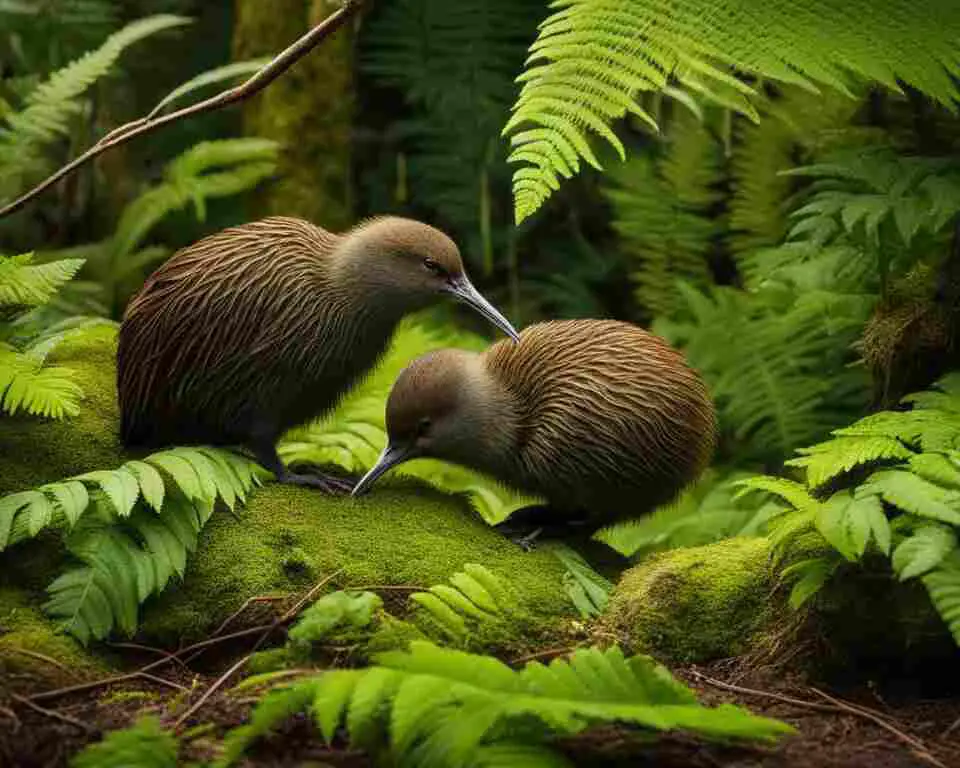Have you ever wondered where kiwi birds call home? These charming birds have made New Zealand their sanctuary, a breathtaking island nation with diverse landscapes. From dense forests to pristine beaches, they’ve found their place. But what draws them to New Zealand? What makes it so appealing?
Join us as we explore the fascinating habitat of kiwi birds, uncovering their unique characteristics and the ongoing efforts to safeguard their future. Let’s embark on a journey to uncover the world of kiwi birds together!
Click the Play button below to listen to our podcast:
Table of Contents
Key Takeaways:
- Kiwi birds are native to the island nation of New Zealand.
- Their natural habitat includes forests, shrublands, grasslands, and coastal areas.
- New Zealand’s diverse environments offer a range of habitats for kiwi birds to thrive.
- Conservation efforts are in place to protect and preserve these unique bird species.
- Understanding the kiwi bird’s native habitat is crucial for their conservation and the biodiversity of New Zealand.
The Enigmatic Origins and Distribution of Kiwi Birds
Kiwi birds are among the most captivating bird species on Earth. Their beginnings and spread have caught scientists’ interest for years. DNA research has revealed their link to Madagascar’s extinct elephant birds. Surprisingly, they’re closer to these birds than to other ratites like the moa.
These birds only live in New Zealand, having formed different species and subspecies. Each kind of kiwi bird is truly unique. For instance, each type, from the North Island brown kiwi to the southern brown kiwi, has its own size, colors, and preferred habitats.
The number of kiwi birds has been dropping due to various threats. Their homes are disappearing, and predators and human actions are harming their populations. This has made kiwi birds endangered, showing the need for action to save them.

| Kiwi Bird Species | Distinctive Features | Habitat Preferences |
|---|---|---|
| North Island Brown Kiwi | Size: Medium | Prefer forests and shrublands |
| Great Spotted Kiwi | Size: Large | Inhabit dense forests |
| Little Spotted Kiwi | Size: Small | Found in grassy areas and coastal regions |
| Okarito Kiwi | Size: Medium | Prefer wetlands and coastal forests |
| Southern Brown Kiwi | Size: Large | Habitat ranges from forests to alpine regions |
Saving kiwi birds is vital. Organizations and programs are working hard to save their homes, control predators, and spread the word about these endangered creatures. With continued effort, we can hope for a future where kiwi birds flourish in New Zealand.
Where Are Kiwi Birds Native To: Their Endemic New Zealand Habitats
Kiwi birds call the island nation of New Zealand home. They are unique to this country, found nowhere else in the world. Both the North and South Islands of New Zealand provide the perfect settings for kiwis.
In the North Island, you’ll find species like the North Island brown kiwi. This area has forests, shrublands, and coastal regions. These varied landscapes give kiwi birds everything they need to live and find food.
The South Island is the home for the southern brown kiwi. They live in forests, shrublands, and grasslands here. The South Island’s unique features offer a perfect environment for them.
Kiwi birds have special places to breed and raise their young. They pick these spots in their native areas to ensure their chicks can thrive. These birds are very territorial, setting up their own space in these habitats.
New Zealand’s special landscapes have helped shape the kiwi birds. They are a key part of the country’s wildlife. Efforts are ongoing to protect kiwi homes, ensuring they stay around for others to see and enjoy.

Conclusion
Kiwi birds are amazing creatures from New Zealand. They live in the North and South Islands. These islands offer them many different places to live and grow.
These birds have special features and ways of acting to fit into their homes. This helps them to live and have babies.
Yet, kiwi birds are facing big problems like losing their homes, being hunted by other animals, and issues caused by people. But, people are working hard to save them. Through conservation work, we aim to keep these special birds safe.
Doing this shows we care about saving kiwi birds. When we help them, we are also looking after New Zealand’s rich nature. Let’s make sure kiwis are here for many years to come.
We need to understand where kiwi birds live to protect them. Keeping their homes safe is key to their future. This way, our kids and their kids can enjoy these extraordinary birds.


